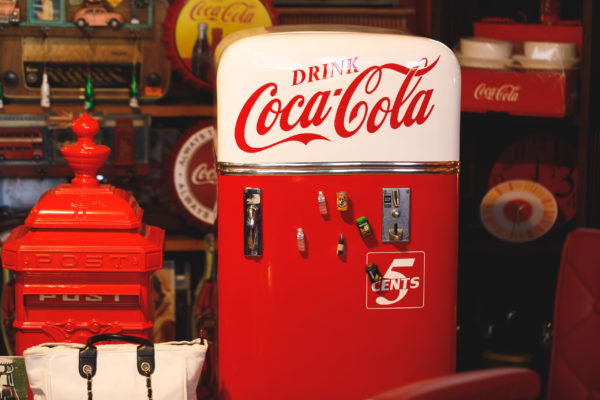We all know that the best way to beat the increasing summer heat in Rock Hill is to enjoy an ice cold Coke. But how to keep those Cokes ice cold? For many years, the best solution for retailers was a Coca-Cola cooler. This month we’ll be looking at the development and history of these useful pieces of Coca-Cola collectibility.
Pre-Electric Coolers
Coca-Cola is best served cold, but when the bottling of the beverage pre-dates widespread mechanical cooling, what’s a shopkeep to do? Simple: the reliable ice chest. Before the 1930s, most Coca-Cola bottles were kept cold in ice. Typically, the coolers would be a simple half-barrel with a wooden lid, although some were constructed of metal. The Icy-O is a good example of the metal models.
Ice-Box Vending?
Usually the customer would simply open the lid to the cooler and pull out a bottle, paying at the counter. In 1910, though, a Georgia bottler invented a coin-operated cooler, dubbing it the Vend-all. The basic idea was sound: plunk a coin in the cooler and get a cold drink. Alas, the machine held a scant 12 bottles, so it wasn’t very practical for retailers. Still…the concept was proven.
The 1920s
Unlike many of the other Coca-Cola paraphernalia items we’ve looked at, coolers during the 1920s were not made available by Coca-Cola itself. Instead, several manufacturers produced coolers for the company. With multiple producers, designs varied considerably.
Glascock Bros. Box
In 1928, Glascock Bros. began manufacturing coolers directly for Coca-Cola. These rectangular coolers with ice above and a rack for empties below were sold to retailers beginning in 1929. Over 32,000 were sold in the first year; they could be purchased for $12.50.
Electric Cooler
Just after the widespread popularity of the Glascock Bros. ice chest cooler, electric models came on the market. With electricity being more easily accessible for most everyone at this point, these electric coolers should have replaced the old ice chest models pretty quickly. With a whopping price-tag of $150 (compared to the $12.50 ice chest model), most retailers couldn’t afford the luxury.
Here to Stay
Even with the relative expense, the electric models were here to stay and gradually replaced the ice chest coolers. In the 1930s, Westinghouse improved on the vending machine concept and designed a model, the Vendo Top, that cooled the Cokes and sold them for a nickel.
Vending Machines Take Over
After World War II, cooled vending machines gradually took over the vast share of the ice chest cooler market. But vending machines are a topic for another month…

